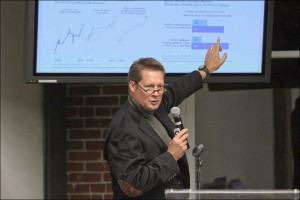Missouri Tests Multi-Platform Storytelling Across Six Newsrooms
By Jim Flink
Originally published to PBS MediaShift; used by permission.
Clutter.
Chaos.
Copious amounts of content.
News organizations are struggling right now.
Struggling to connect with users, who are migrating to increasingly diverse and cluttered platforms.
Struggling to migrate their staffs, sometimes chaotically, to distribute distinct, quality, multi-platform content to different and varied platforms.

Struggling to see the strategy, as every news organization adopts similar migration patterns, that might end up spurring sequential and replicable usage patterns which could lead to new monetization streams.
None of which sounds new for anyone engaged in the business of news.
Start-Up Success
In my four years as vice president of news and then general manager at news start-up Newsy, we faced those same struggles. And we faced the prospect of irrelevance.
Never a part of the 500+ channel universe, never landing in a driveway, never holding a spot on the dial, let alone in drive-time, we had to resonate with no historical following. We were mobile-first before mobile-first was cool. We had to play big, despite being quite small.
Because of those challenges, innovation became our watchword. Our motto: Know what’s coming next, and be there first. Get noticed. It was, and remains, one key harbinger for success in this massive migration.
Four months ago, I migrated to a consultant position with the Donald W. Reynolds Journalism Institute at the Missouri School of Journalism. The challenge? To take what I learned from helping to build Newsy to other interested news entities within the School.

Technologies of Storytelling
The outgrowth of those conversations led to the creation of a section of JOURN 4462 Emerging Technologies. Six newsrooms signed up to be a part of an experiment: KOMU-TV (the local NBC affiliate), KBIA-FM (NPR), Global Journalist, Investigative Reporters and Editors, Missouri Business Alert and Treepple, which engages in targeted health news and marketing initiatives. Each newsroom has been assigned a small tactical team of vertically integrated, advanced students who have significant experience in multi-platform content gathering and distribution.
Our hypothesis? Different content optimizes to different platforms at different points in a progressive storytelling process. For instance, slideshows, “Five Things to Know,” and other short, easy-to-consume elements resonate on mobile phones. But because mobile has varying screen sizes and optimization opportunities, video clips and data visualization might resonate better on a tablet. The Web becomes a placeholder for content early in the process, and then a repository or library for the sum of a day’s work or a story’s life cycle. And then there is the core product, “the show” or the paper or the newscast. Less and less likely to be the place where news is broken, it’s where depth is provided and value added. This is to say nothing of the role of social media and of how content is parsed in platform-specific and exclusive ways.
As an added dimension, each participating newsroom’s tactical team will engage in quite varied content strategies. This approach stands to reason, as the audiences for an NBC affiliate, a Web-based resource for investigative journalists and a targeted news and marketing health initiative will each have different objectives. In our class, each team will operate independently from one another and in concert with each newsroom’s leadership, but will then convene once each week to assess shareable learning outcomes.
Searchlights and Sunglasses
As our textbook, I adopted “Searchlights and Sunglasses: Field Notes from the Digital Age of Journalism” by Eric Newton. Newton, of the Knight Foundation and a Reynolds Journalism Institute fellow, has created a digital textbook that is relevant to modern learning in its form and function. Its contents are vital to new journalists keeping up with the breathtaking pace of change journalists now face.

In designing this course, we at the Reynolds Journalism Institute consulted our deep research, our ongoing experience in the trenches and our gut. Believing journalists can no longer think of themselves as agenda-setters or gatekeepers, this class seeks to test new modes of content distribution which, in part, mirror consumer usage patterns. The goal? To create content that will result in replicable, sequential patterns of usage, from platform to platform, from mobile to social to web to core, all of which can be measured, quantified and potentially monetized over the longer-term.
It is a large undertaking. Our industry is investing heavily in models that have found ways to resonate in the marketplace. New products. New partnerships. New ways of thinking about everything from innovation to infrastructure, workflow to mindset, audience to analytics and so much more.
And so we begin. Incubating new ideas, fostering learning and anticipating what comes next are what universities have always done best. In journalism, the Missouri School of Journalism has a rich tradition founded and imbued in the Missouri Method. Students have always learned by doing, and have become the early innovators, adopters and leaders of what comes next. This time what comes next is coming at a blinding rate of speed, morphing our industry in ways we may not even yet comprehend.
Jim Flink is working with the Reynolds Journalism Institute (RJI) at the Missouri School of Journalism, focusing on best practices in mobile, video news content and production, as well as distribution and monetization strategies. During his previous four years as vice president of news operations, and then general manager of Newsy, he led, coached and cultivated a young startup newsroom into an established, strong, internationally respected newsroom publishing quality video content on emerging digital platforms.
Updated: July 22, 2020